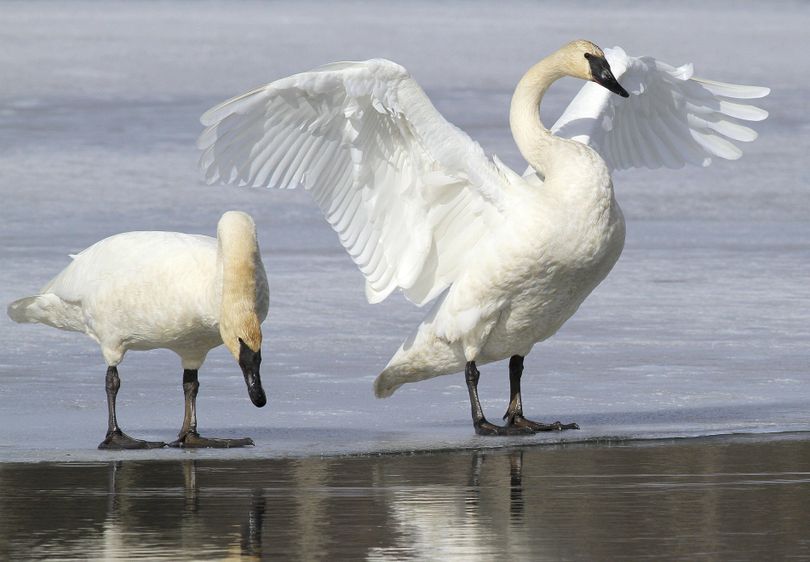Trumpeter swan hunting proposal alarms birders

BIRDNG – A federal plan to let hunters shoot trumpeter swans has drawn fire from some of the people who toiled to bring the majestic white birds back from the brink of extinction.
Here's the story from the Associted Press out of Minnesota:
Trumpeter swans, North America’s largest waterfowl species, have made a comeback in recent decades thanks to efforts to reintroduce them to their former breeding range. Now the U.S. Fish and Wildlife Service is working on a plan that would let hunters shoot them in several states that allow the hunting of tundra swans, a more numerous species.
“Trumpeter swans are a conservation success story,” said Brad Bortner, chief of the service’s migratory bird management division. North America’s population is estimated at more than 63,000 adult birds and it’s growing by more than 10,000 a year, he said.
No state is currently proposing trumpeter swan seasons, he said, and the proposal is mostly aimed at protecting tundra swan hunters in five states who may mistakenly kill trumpeter swans. But he acknowledged the proposal opens the door to the possibility that some states could offer such a hunting season. The soonest the proposal could take effect is 2019-2020 season.
Tundra swans look almost identical to trumpeter swans, especially at a distance, and a tundra swan hunter who mistakenly shoots a trumpeter is subject to a fine. That rarely – if ever – happens. But the risk is expected to grow as trumpeter swans spread from states that have invested heavily in restoration efforts, such as Minnesota, Iowa, Wisconsin and Michigan in the Mississippi Flyway.
The proposal essentially would make such incidental kills legal by letting states with low trumpeter numbers hold general swan seasons rather than specific tundra swan seasons. The service already allows something similar in the Pacific Flyway in Utah and Nevada. The new plan would most directly protect tundra swan hunters in Montana, North Dakota, South Dakota, North Carolina and Virginia.
But that approach doesn’t sit well with some bird lovers, including the man who led the restoration effort in Minnesota, where the trumpeter swan population has grown over the past 35 years from none to more than 20,000. Carrol Henderson, supervisor of the Nongame Wildlife Fund at the Minnesota Department of Natural Resources, personally brought back the eggs from Alaska that seeded the state’s flock in the 1980s.
Speaking for himself, not the state agency, Henderson said he fears the federal plan puts at risk a population that Minnesota brought back using about $500,000 raised through a program that lets people contribute by filling in a box on their income tax forms. He said the state pledged that the trumpeters would never be hunted, and he said waterfowl hunters are turned off by the idea of hunting them.
“If a proposal were made to turn it into a game species, I think the agency would suffer a huge black eye,” he said.
The Fish and Wildlife Service put the plan out for public comments this summer. Officially, it’s called a “draft environmental assessment” for a “proposal to establish a framework for general swan hunting seasons in the Atlantic, Mississippi and Central flyways.” The online comment period closes Sunday. As of Friday, the comments were running heavily against any trumpeter swan hunting, though one Minnesota tribe supports the proposal because trumpeters have grazed so heavily on one of its best wild rice lakes that they’ve become pests.
Henderson recommended maintaining the existing ban on swan hunting in the Mississippi Flyway. In the Atlantic and Central flyways, which include the five states the plan is aimed at, he would change the rules so game wardens would confiscate trumpeter swans accidentally shot by hunters, but not fine the hunters. He said Minnesota did that for a goose species that was once protected.
“I’m not sure that sort of simplicity is something that flies well in Washington, but it worked here in Minnesota,” he said.
